|
That Fateful Day:
August 16, 1999
The story of how we found the boat, our
first visit, and getting her ready
for a frightful journey from the island to our backyard.
|
|
Please
click here to see a series of photos of the boat the way we found her at
Chebeague Island Boatyard! |
|
The Idea...
We had owned
our Ensign for only a little over a year when
the bug hit. My then-fiancée Heidi and I
(we're now married) were out sailing in the bay one beautiful July day, when I noticed one of the
local Tritons sailing nearby. I had often seen this particular boat out
when I was sailing, and always admired her lines and sailing ability.
"Someday," I said to Heidi, "a Triton like that would be a nice
small cruising boat for us to move up into. Then, we could go off cruising
for weekends, a couple weeks here and there..."
Anyway, Heidi
thought it was a nice looking boat, and we spent a little more time talking
about the prospects of owning one someday. I had recently painted the
Ensign with Awlgrip and was brimming with confidence after my general success at
that small project. "Why not, when the time comes, look for an old,
beat-up Triton that we can buy fairly cheap and do a little work to?", I blithely
said. "It would be fun to have another project." To make a
long story short, Heidi, bless her heart, thought it was a great idea.
Within a few
days, I was spending as much spare time as I could surfing the web for
information on Tritons and the prospect for restoring one. I found some
interesting websites packed with information, photos and others' projects.
The projects detailed on these sites gave me the
inspiration I needed to know that a project boat was something I wanted. I
figured there was no rush, and eventually an old Triton meeting my requirements
would come to light.
The
Purchase...
In the first
week of August, 1999--only a couple weeks after our fateful conversation--I was
browsing the classified ads on the NTA site, when I happened upon an ad that was
too fortuitous to ignore:
1967
Triton in middle of restoration by x-marine industry professional. 1/2
of deck recored, second half needs recoring in a couple of spots. Hull
is in beautiful shape. Rig looks to be in great shape, currently in
boatyard storage (I never had it up). Roller furling jib, two anchors,
plenty of gear (new and original), original Atomic 4 which was running when it
came out of the water 6 years ago (according to previous owner). Boat is
located on Chebeague Island, Maine off coast or Portland. I'm in New
Jersey (need I say more) $2500 firm
Now, Chebeague
Island could hardly be closer to our stomping grounds in Casco Bay. It
sort of seemed to be too good to be true--low price, half the deck recored, and in
our backyard, so to speak. I showed the ad to Heidi, got the go-ahead, and
called the ad placer. After a brief conversation, we had made arrangements
to visit the boat on the island the following week, when the owner was
previously scheduled to be on vacation at his parents' home on the island.
Everything was falling nicely into place.
A note about
the advertisement: we quickly figured out that the boat was not a
1967--more like a 1963, we figure, and as for the rest of the ad--well, check
out the rest of this site to see for yourself. I had fortunately
planned on the boat being in really poor condition, and was prepared for the
worst when we got ready to see the boat.
Going to
Chebeague for the day turned out to be an adventure in itself. Because of
limited parking and town politics (which I don't need to go into here), going to
Chebeague requires driving inland about 5 miles to Cumberland in order to park
and ride a shuttle bus to the ferry dock on Cousins Island in Yarmouth. We
rose early on that hot, beautiful August morning and were waiting when the bank opened
to get some cash
ready for our likely purchase. We figured that the boat would have to be
pretty horrible--as in unsalvageable--for us not to buy it for the price
listed. We hoped to talk the owner down a little, though, and figured cash
in hand would be a great way to do that.
We drove out
and got on the bus, and took the long ride from the center to the wharf on
Cousins Island, where we boarded the ferry for our 10 minute ride across to
Chebeague. Lo and behold--what were the chances--we ran into my father,
his wife and sister in law on the ferry. They were headed out to do some
biking. We hadn't told anyone about our thoughts, but we had to come
clean then. I'm not sure they understood quite what we were talking about
at the time.
|
|
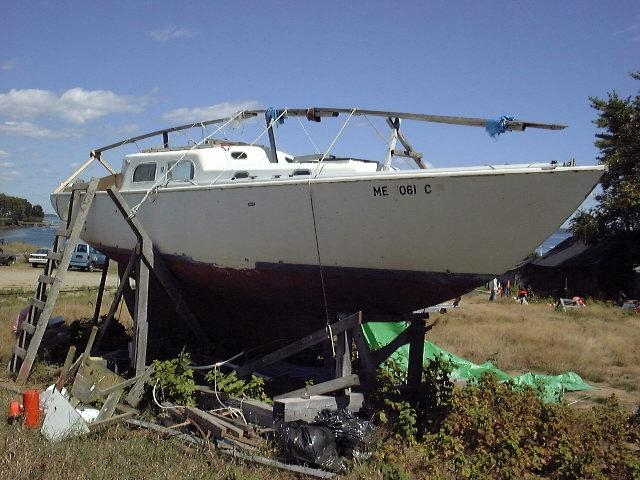 We
met the owner and rode over to the boatyard on the other side of the
island. There she was--Sea Dog, sitting on an old marine railway
cradle in the middle of a hot, dusty field surrounded by junk and unmown weeds
and field grass. The torn green tarps hanging off one side and the rough
framing over the deck completed the picture. We
met the owner and rode over to the boatyard on the other side of the
island. There she was--Sea Dog, sitting on an old marine railway
cradle in the middle of a hot, dusty field surrounded by junk and unmown weeds
and field grass. The torn green tarps hanging off one side and the rough
framing over the deck completed the picture.
|
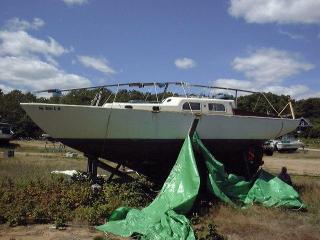 The boat was
everything I had expected--that is, she was in every bit as poor condition as I
had thought she would be! One side of the deck had indeed been recored,
but was not yet complete--there was raw fiberglass over the top of the core, in
varying thicknesses depending on how far he had gotten. The gelcoat on the
rest of the deck was full of fine crazing and dirty, and the starboard side was
trampoline-like. There was spilled resin everywhere, and the boat
generally presented a pretty scary appearance. It looked exactly like she
hadn't moved in over six years, as advertised. The boat was
everything I had expected--that is, she was in every bit as poor condition as I
had thought she would be! One side of the deck had indeed been recored,
but was not yet complete--there was raw fiberglass over the top of the core, in
varying thicknesses depending on how far he had gotten. The gelcoat on the
rest of the deck was full of fine crazing and dirty, and the starboard side was
trampoline-like. There was spilled resin everywhere, and the boat
generally presented a pretty scary appearance. It looked exactly like she
hadn't moved in over six years, as advertised. |
|
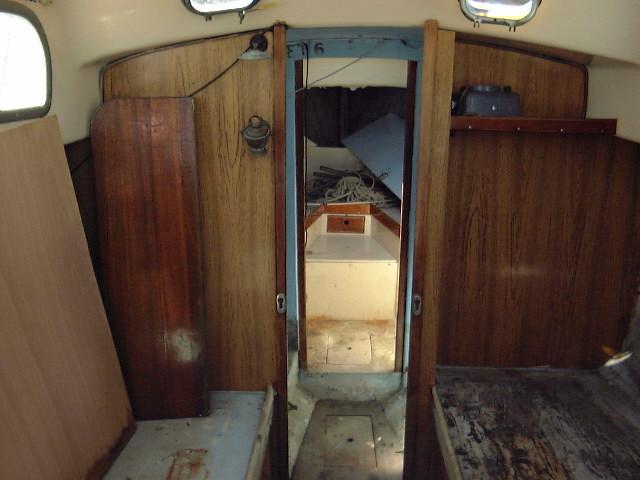 The
interior was a horror show of peeling paint, oily residue from when the boat
filled up with water during the winter a couple years ago (disclosed by the
owner), lifelines and other gear were strewn everywhere, and the smell...well, it
can't be described, but if you've ever been on an old boat that's been sitting
neglected for a while, I'm sure you have some idea what I mean. The
interior was a horror show of peeling paint, oily residue from when the boat
filled up with water during the winter a couple years ago (disclosed by the
owner), lifelines and other gear were strewn everywhere, and the smell...well, it
can't be described, but if you've ever been on an old boat that's been sitting
neglected for a while, I'm sure you have some idea what I mean.
|
|
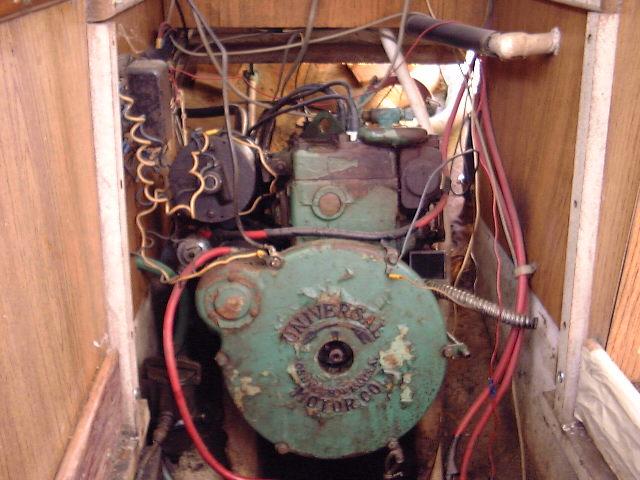 The
engine room was a mass of old wires surrounding a horrible-looking ancient green
hunk of metal, also known as an Atomic 4. It didn't look too happy to
me. Access in and around the engine was awful, and I couldn't see keeping
things the way they were. The
engine room was a mass of old wires surrounding a horrible-looking ancient green
hunk of metal, also known as an Atomic 4. It didn't look too happy to
me. Access in and around the engine was awful, and I couldn't see keeping
things the way they were.
We spent
several hours on the boat--tied down by the ferry schedule, but also because it
was a beautiful day and we were enjoying ourselves. My dad stopped by on
his bike and looked the boat over. I think he thought I was pretty much
wacked until I told him the price--then it seemed to make a little more sense.
|
|
The mast was removed
from its storage place in the rafters of the barn--where it had been stored
complete with rolled-up genoa on the furler, which now looked like it had been
the roost for about a million birds. One of the jumpers was bent, and the
rig generally looked old and beat.
After a couple
hours, I was ready to try my hand at negotiation. After coming to an
agreeable price, we signed a few pieces of paper I had prepared, and I spoke quickly
to the yard owner to determine the difficulty in getting the boat into the water
so we could get her back to the mainland. Then, because we were suddenly
out of time, we rushed to the ferry for the trip home, running into, again, my
dad et al. We gave them the exciting news. For better or for worse,
in a matter of the past few hours we had become Triton owners!
Preparing
for the Tow...
After completing the purchase of the boat on August 16, 1999, we were faced with a small problem: how to get the boat home. When we purchased her, she was located on an island in Casco Bay, Maine--not exactly
conducive to a major renovation, nor to easy truck transport. She
was also incapable of operating under her own power--or at least I wasn't going
to try. Therefore, she had to be launched--for the first time in six or seven years--and
towed to the mainland, where she could be hauled again for transport to our backyard, where she would remain during the renovation.
I was of course a little nervous about launching the boat, as I was worried
about the condition of the stuffing box and the seacocks, the most likely and potentially
devastating things to fail.
The first order of business was to find a way to tow the boat back to the mainland--about a seven mile journey. Fortunately, our friend Scott volunteered his Whaler for the job, a task it proved well suited to. Next, we had to schedule the launching at the very laid-back boatyard--which was accomplished with a few phone calls. The yard was great, and went over and above the call of duty in getting the boat ready for launch--I guess they were glad to be rid of the old girl. We made plans to go to the island on Friday, August 20, to prepare the boat for the launching and journey
home, scheduled for the following Monday and Tuesday. On the project list: place the unstepped mast on board, seal the stuffing box, check all seacocks, and rig up a towing bridle. There was no deck hardware on board, having been removed by the previous owner at the beginning of his re-core project, so some thought went into the best method for tie-up.
|
|
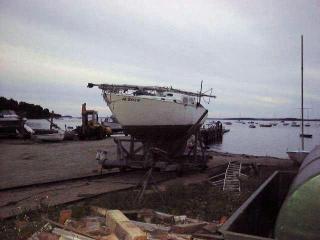 Upon arrival in Scott's boat, we were amazed to not only see the boat perched on the railway, ready for launching, but also the mast and assorted gear already secured aboard--a very pleasant surprise. Once ashore, we set to the remaining tasks, including
resecuring the mast and sealing the outside of the stern tube (see below) with silicone caulk for the trip--as I was worried about the integrity of the age-old hose and packing in the stuffing box.
As I was occupied on deck, I asked Scott to take care of the sealing, which he
did--but I failed to check it myself and missed a crucial area, which was to create headaches later on... Upon arrival in Scott's boat, we were amazed to not only see the boat perched on the railway, ready for launching, but also the mast and assorted gear already secured aboard--a very pleasant surprise. Once ashore, we set to the remaining tasks, including
resecuring the mast and sealing the outside of the stern tube (see below) with silicone caulk for the trip--as I was worried about the integrity of the age-old hose and packing in the stuffing box.
As I was occupied on deck, I asked Scott to take care of the sealing, which he
did--but I failed to check it myself and missed a crucial area, which was to create headaches later on...
I set up a
towing bridle around the bow by attaching two small shackles to the chainplates,
then tying a rope between the two and around the bow. We also retied the
mast, using whatever we could to tie to on the boat, including running lines
through the cockpit locker cover drain holes and up to the mast.
|
|
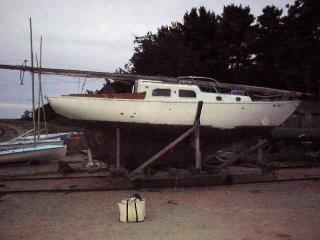 As we worked, several people stopped by to chat and find out what our plans were. It's amazing how these Tritons attract attention, even when (or perhaps because) one is in poor condition.
One guy, who owned another Triton that was on a mooring in the anchorage, said
he had been eyeing the rudder on Sea Dog/Glissando! I guess he
figured the boat was a goner--and she might well have been, were it not for us. As we worked, several people stopped by to chat and find out what our plans were. It's amazing how these Tritons attract attention, even when (or perhaps because) one is in poor condition.
One guy, who owned another Triton that was on a mooring in the anchorage, said
he had been eyeing the rudder on Sea Dog/Glissando! I guess he
figured the boat was a goner--and she might well have been, were it not for us.
Having completed the work list, we headed for home, as it was growing dark.
The boat was scheduled to be launched on Monday at the high tide, so we planned to return Monday evening to tow the boat to the Portland Yacht Club in Falmouth, where we expected the boat would ride overnight on a mooring before a Tuesday morning haulout.
I had initially thought of heading back over early in the morning of the two
(Tuesday), but, in an extremely fortuitous moment, Scott suggested we get the
boat on Monday so that it would be ready to go easily on Tuesday morning.
|
|
The Tow...
Monday, after work, we met at
PYC for the trip over to the island. It had been a perfect day, clear and calm--perfect for towing a derelict. I had confirmed in the morning that the boat had been launched, so we happily headed out. Almost immediately, as we drove away from the shore, we noticed dark clouds looming--boomers! Not my idea of great weather in which to tow a dead boat. Nonetheless, we continued out to the island, where, upon rounding the corner, we gazed upon our new boat, afloat for the first time in so many years...sort of! I immediately noticed that the boottop was NOT visible--yikes.
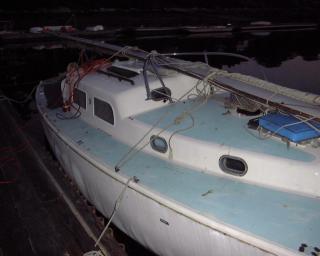 Now, realize
that gaining access to the inside of the boat was made extremely difficult
because the mast was resting heavily upon the companionway slide, and it was
nearly impossible to remove the swashboards. Untying part of the mast in
an adrenaline-fueled frenzy, I shouldered under it and pried the boards out so I
could get inside. Plunging into knee deep, oily, crap-filled water at the
base of the companionway,
I
saw that the floorboards were under about 12" of water. This was not a good sign! Meanwhile, thunder and lightning was all around, although we weren't in a storm--at least yet. I had
come prepared for some minor leakage--it was an old boat, after all--and I had a battery and an electric
bilge pump with me (along with what I thought would be the most important equipment that night--beer and chips), so I went below and hooked the pump
up, trying to be as calm as possible. Within a few minutes, it was apparent that the water level was dropping, so I decided to go ahead--albeit
nervously--with the tow. Friday night, we had rigged a bridle by attaching lines to two shackles that I attached to the chainplates--the only thing remaining on board that we could tow from. This arrangement worked like a charm, and we were soon heading for home at a comfortable six knots with no straining at all. The water level continued to drop, the thunderstorms missed us (close, though!), the seas and wind were calm, and we soon were back in sunshine, with the beautiful sunset beginning.
The water was still coming in, but we soon could see the bottom of the bilge
again, and we were able to semi-relax for the rest of the 5-knot tow home. Now, realize
that gaining access to the inside of the boat was made extremely difficult
because the mast was resting heavily upon the companionway slide, and it was
nearly impossible to remove the swashboards. Untying part of the mast in
an adrenaline-fueled frenzy, I shouldered under it and pried the boards out so I
could get inside. Plunging into knee deep, oily, crap-filled water at the
base of the companionway,
I
saw that the floorboards were under about 12" of water. This was not a good sign! Meanwhile, thunder and lightning was all around, although we weren't in a storm--at least yet. I had
come prepared for some minor leakage--it was an old boat, after all--and I had a battery and an electric
bilge pump with me (along with what I thought would be the most important equipment that night--beer and chips), so I went below and hooked the pump
up, trying to be as calm as possible. Within a few minutes, it was apparent that the water level was dropping, so I decided to go ahead--albeit
nervously--with the tow. Friday night, we had rigged a bridle by attaching lines to two shackles that I attached to the chainplates--the only thing remaining on board that we could tow from. This arrangement worked like a charm, and we were soon heading for home at a comfortable six knots with no straining at all. The water level continued to drop, the thunderstorms missed us (close, though!), the seas and wind were calm, and we soon were back in sunshine, with the beautiful sunset beginning.
The water was still coming in, but we soon could see the bottom of the bilge
again, and we were able to semi-relax for the rest of the 5-knot tow home.
We arrived at the PYC dock after a relatively--under the circumstances--nice tow of about 1 1/2 hours. The boat was dry, although water continued to come in. Thinking that the packing nuts needed tightening, we accessed the stuffing box and went to work--soon realizing that these attempts were futile, as the hose was in danger of breaking if we messed around too much. A hole in the hose was allowing water to rush in to the boat in a 1/4" stream-although at the time, I couldn't figure out why the sealant outside wasn't keeping the flow out.
|
|
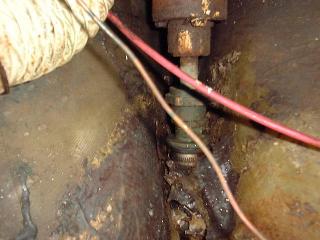 Obviously, we weren't going to be leaving the boat for the night, as we were in serious danger of losing her if left unattended. I headed home quickly to pick up a large electric sump pump, blankets, snacks, a pizza and other supplies for what was to become our full night of watching, pumping and camping out at the PYC dock. Attempts to stem the water inflow were unsuccessful, as we couldn't properly access the leak in the hose.
You can see in the photo how tight the access to the sides of the hose
was--there was really no room to get in there. Also, I didn't want to put any
more pressure on the old rotten hose, lest I make a bad problem worse by
enlarging the hole! Obviously, we weren't going to be leaving the boat for the night, as we were in serious danger of losing her if left unattended. I headed home quickly to pick up a large electric sump pump, blankets, snacks, a pizza and other supplies for what was to become our full night of watching, pumping and camping out at the PYC dock. Attempts to stem the water inflow were unsuccessful, as we couldn't properly access the leak in the hose.
You can see in the photo how tight the access to the sides of the hose
was--there was really no room to get in there. Also, I didn't want to put any
more pressure on the old rotten hose, lest I make a bad problem worse by
enlarging the hole!
|
|
Our Long
Night...
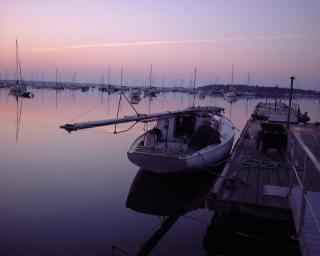 So, rather than go home to a snug bed, Heidi (what a sport!) and I ended up hunkered down in the cockpit of our dirty, nasty old "new" boat. The interior was damp and full of boat gear and junk, so the cockpit was our best bet--even with the mast and jumpers hanging in our way. Because the electric pump was manual only (no float switch), we had to stay and watch the water level. We'd let the water come up a few inches over the floor
and then plug the pump in till dry. The inflow was so fast that it took only 25 minutes from dry until the water was four inches over the cabin sole. It then took 10 minutes of pumping to dry it out again. We kept this up all night, taking turns catching naps. As it happened, it was a perfect night, with calm winds, relatively warm temperatures, and gorgeous clear skies with a nice moon. Looking back, we actually had a pretty good time, were it not for the anxiety of losing the boat. We ate pizza, read, walked the dock and watched the stripers (bass) beneath the floats, attracted by the light. So, rather than go home to a snug bed, Heidi (what a sport!) and I ended up hunkered down in the cockpit of our dirty, nasty old "new" boat. The interior was damp and full of boat gear and junk, so the cockpit was our best bet--even with the mast and jumpers hanging in our way. Because the electric pump was manual only (no float switch), we had to stay and watch the water level. We'd let the water come up a few inches over the floor
and then plug the pump in till dry. The inflow was so fast that it took only 25 minutes from dry until the water was four inches over the cabin sole. It then took 10 minutes of pumping to dry it out again. We kept this up all night, taking turns catching naps. As it happened, it was a perfect night, with calm winds, relatively warm temperatures, and gorgeous clear skies with a nice moon. Looking back, we actually had a pretty good time, were it not for the anxiety of losing the boat. We ate pizza, read, walked the dock and watched the stripers (bass) beneath the floats, attracted by the light.
|
|
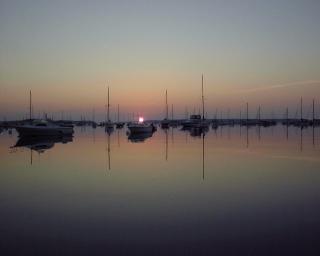 As dawn arrived, we were in for a treat: one of the prettiest sunrises I have ever had the pleasure of witnessing. The temperature warmed rapidly, and soon the discomfort of the previous night was fading. No harm done, as the pump never failed, and what damage could possibly be done to the interior of the boat? As the early morning wore on, it seemed that the packing actually swelled, slowing the leak to a trickle about an hour before
haulout. Go figure! As dawn arrived, we were in for a treat: one of the prettiest sunrises I have ever had the pleasure of witnessing. The temperature warmed rapidly, and soon the discomfort of the previous night was fading. No harm done, as the pump never failed, and what damage could possibly be done to the interior of the boat? As the early morning wore on, it seemed that the packing actually swelled, slowing the leak to a trickle about an hour before
haulout. Go figure!
|
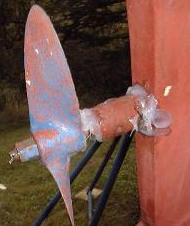 After getting
the boat home, I inspected the supposedly sealed stern tube and at first
couldn't figure out why it had leaked. However, I finally noticed an old
setscrew hole for the cutless bearing--on the bottom of the fiberglass stern
tube, where I had never looked. This 1/4" hole was all that was
needed to create the problem that kept us up all night. Everything else
had been sealed! After getting
the boat home, I inspected the supposedly sealed stern tube and at first
couldn't figure out why it had leaked. However, I finally noticed an old
setscrew hole for the cutless bearing--on the bottom of the fiberglass stern
tube, where I had never looked. This 1/4" hole was all that was
needed to create the problem that kept us up all night. Everything else
had been sealed! |
|
|
Click here
to see the remainder of Glissando's journey home to the project site. |
|